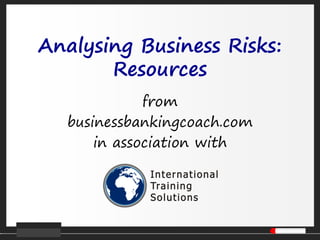
Analysing business risks; resources
- 1. Analysing Business Risks: Resources from businessbankingcoach.com in association with
- 2. Every business needs some resources to function properly. It’s important in credit assessment to get a feel for how well these resources are managed and maintained.
- 3. These resources can be broadly classified as; Physical resources; e.g. property, plant and equipment, vehicles Financial resources; owners’ capital and access to external funding such as bank loans, and Human resources; e.g. skilled workers, unskilled workers and staff
- 5. For the moment we can leave the financial resources out of the discussion as we consider the business’s financial position in other presentations.
- 6. Property; the bank will be interested to know whether the property from which the business operates is owned or leased and whether it’s in good condition and suitable for the purpose of the business’s operation.
- 7. The reason for this is that, if the property is owned by the business, it might give the bank an opportunity to obtain some tangible collateral, should it be required.
- 8. To explore this collateral possibility further, the bank would want to know the current market value of the property and whether there is already a mortgage bond registered in favour of another lender.
- 9. Even if the bank does not require collateral, any surplus value in the property will certainly serve as a potential secondary source of repayment should something go wrong with the business’s cash flow in the future.
- 10. If the property is leased, important questions to consider are the length of time remaining on the lease, the current lease payments and the annual escalation clause, if any, so that the bank can get a sense of current and future financial commitments and whether the lease payments will put a strain on future cash flow.
- 11. Finally, whether the property is owned or leased, the bank would want to ask whether there will be a need to expand or to move to alternative premises in the near future.
- 12. Plant & machinery; is there a need to replace plant and machinery? Is it well maintained and is it reasonably up-to-date technology? What will be the cost of replacement and has the business made any provision for replacement?
- 13. Labour; the bank will want to know about the labour component as far as it might impact on the business’ operations.
- 14. For example, if the workforce is highly skilled because the business provides a very technical service to its customers, its continued operation would be reliant on the workforce being retained and fully functional.
- 15. There is a risk in this case that, if there are generally very few people available with the necessary technical skills, the current workforce will wield more power over the management than would normally be the case and it may be difficult for management to implement policies and procedures that may not be to the advantage of the workforce.
- 16. Also, consider how close the business is to its labour resource – does the workforce have to travel long distances to get to the business and is there a supply of labour available?
- 17. Operational capacity; this refers to whether the business is operating at full capacity or can still increase its operational output without requiring additional resources such as factory space, warehouse space, labour and so on.
- 18. This will give the bank an idea of whether the business can grow its revenues without additional investment in fixed assets or working capital as doing so will enable it to generate additional free cash flow.
- 19. Forex; does the business deal in foreign currencies, either by making sales overseas or buying materials and inputs from a foreign supplier?
- 20. Are Forward Exchange Contracts used to fix the local currency value at the time of order/sale? Are Letters of Credit required for imports of raw materials or other inputs? Is there a danger of transfer risk or convertibility risk?
- 21. We do hope that you enjoyed this presentation. For more commercial and business banking content, please visit our website at www.businessbankingcoach.com where you can subscribe to our blog, listen to our podcasts or view and download our other Slideshare presentations. If you have any questions about this presentation or any of our other content, please send us an email at support@businessbankingcoach.com
